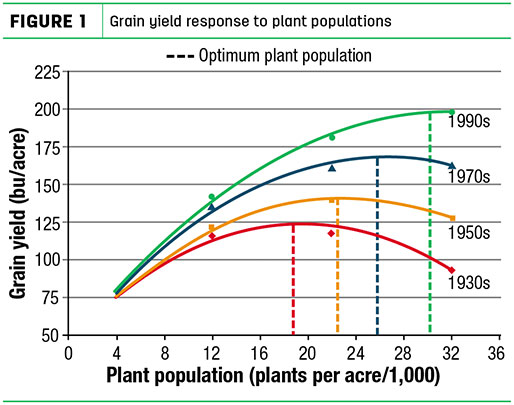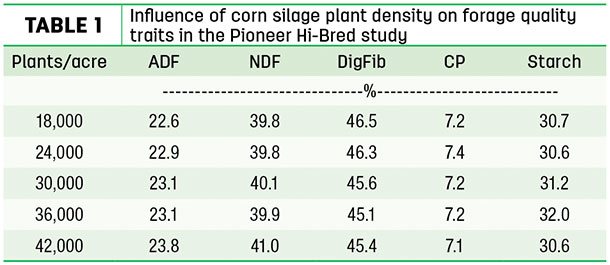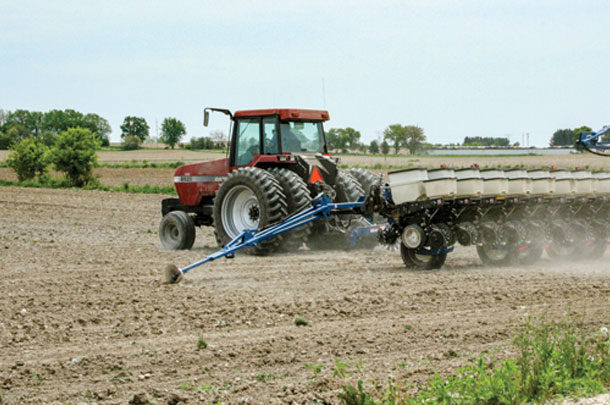This article focuses on how plant populations may affect corn silage quality and tonnage.
It is important to target plant population based on individual hybrid recommendations. Some hybrids respond well to higher populations, and some respond negatively. Similarly to people: Some people like crowds; however, some get claustrophobic.
Over the last 25 years, in the U.S., the average corn planting population has risen from 23,000 plants per acre (PPA) to about 30,000 PPA. High-yielding environments allow for increasing populations to 36,000 to 38,000 PPA, depending upon individual hybrid genetics.
Another consideration is that typical seed corn germination is about 95 percent, so over-planting by at least 5 percent can help reduce the effects of germination-induced skips and for expected reductions due to insects and soil conditions.
Summarizing corn population research is challenging because varying maturities across diverse growing environments make it difficult to draw sweeping conclusions. Traditional recommendations have been to increase plant populations in hybrids destined for silage by 10 to 20 percent per acre.
However, with the increasing value of starch, newer recommendations suggest planting silage at no more than 2,000 to 3,000 PPA above the recommended planting population for that hybrid if planted for grain.
Higher planting populations (in excess of 30,000 PPA) provide modest improvement in grain yield production. This is due to higher leaf area index, which allows for more efficient photosynthesis and a greater number of kernels per ear and weight of each kernel.
However, the genetic selection of corn hybrids for stress tolerance has accounted for the vast majority of the 1 to 1.5 bushels per year grain yield increase over the past 80 years. This is a result of higher population increasing the number of ears per acre.
More precise soil fertility practices and technology traits which improve resistance to insect and weed pressure have also significantly improved average yields.
The yield is further driven by the fact that the average grower is planting about two weeks earlier than in the past, somewhat the result of improvements in seed treatment options.
Figure 1 looks at grain yield response to plant populations of hybrids from four eras of plant breeding.

Vertical lines indicate optimum plant populations for each era.
Higher populations might provide more yield of stover (Figure 2) but can reduce yields of starch (grain).

Higher plant populations tend to decrease stalk diameter and increase potential for lodging.
This is much less of a concern for silage than for grain corn harvested at a much later maturity. Research has consistently demonstrated that higher populations (upwards of 40,000 to 42,000 PPA) increase silage yield while decreasing quality slightly.
The decrease in quality is caused by increased stover yield diluting the grain (starch) portion of the plant, causing slightly higher fibre levels as shown in Table 1.

Some earlier research suggests the smaller-diameter stalk found in higher populations caused slightly lower fibre digestibility.
More recent research conducted in 2008 and 2009 by Cornell University with conventional, leafy and BMR hybrids planted at populations ranging from 25,000 to 40,000 PPA showed no significant effect of increasing population on fibre digestibility.
A very important factor to remember is that the hybrid’s growing environment has a large effect on fibre digestibility, in fact three times more than genetics. During hot, dry weather, fibre digestibility is higher than in a cooler, wet summer.
Some silage growers prefer to plant at lower populations, which is more optimal to grain yield, in an attempt to increase the starch content of silage in response to increasing supplemental grain prices.
A healthy corn crop can deposit as much as 0.5 to 1 percentage units additional starch per day from one-third milkline to physiological maturity (black layer).
Higher grain deposition contributes significantly to corn silage tonnage yields. Therefore, harvesting at later maturity also will produce higher tonnes per acre.
Newer hybrids containing technology traits deliver excellent late-season plant health, so delaying harvest until three-quarter milkline (or later) will result in higher-starch corn silage without a significant decline in fibre digestibility.
If the crop is stressed or diseased, there is increased tendency to have a lower fibre digestibility from delaying harvest to these later stages.
Based on what is known about today’s elite genetics, planting at higher planting rates and harvesting the crop at the later three-quarter milkline maturity will produce corn silage high in starch and yet will not be detrimental to fibre digestibility.
Growers should not rely on ear flex scores when considering planting populations. Ear flex refers to the ability of a plant to extend ear size as plant density is reduced or as growing conditions improve.
Many seed companies have abandoned evaluating ear flex and advise growers to rely on actual population recommendations from research trials planted at upwards of 70,000 PPA.
Ear flex scores have their primary utility in deciding if a hybrid has the ability to deliver higher yields under possible replant situations such as emergence problems or hail, which reduces populations to less than 12,000 PPA.
Corn silage inclusion is often the greatest ingredient for many dairy rations across the country; therefore, producing high-quality corn silage in the field becomes a major factor for growers.
Selection of hybrids characterized for silage and possessing desired agronomic traits, along with using technologies and implementing best management growing practices, will produce high tonnes per acre of high-quality corn silage from the crop.
The end result means nutritionists can formulate a more efficient and economical ration for maximizing milk-to-feed cost ratios for the dairy producer. ![]()
PHOTO: Based on what is known about today’s elite genetics, planting at higher planting rates and harvesting the crop at the later three-quarter milkline maturity will produce corn silage high in starch and yet will not be detrimental to fibre digestibility. Photo by Karen Lee.

-
Martina Pfister
- Dairy Specialist – Central/Eastern Ontario and Maritimes
- Dupont Pioneer – Canada
- Email Martina Pfister










